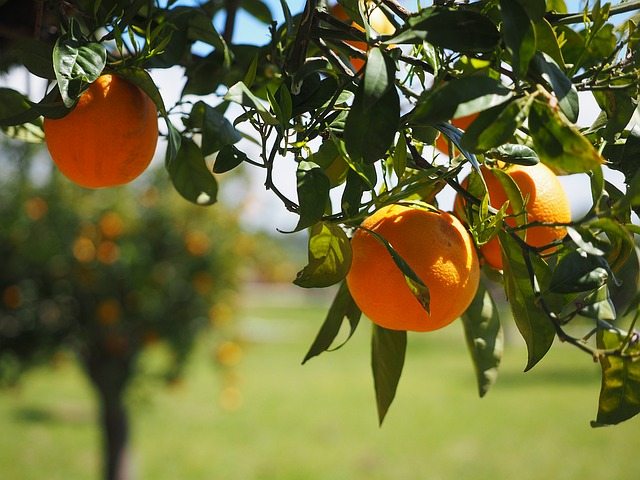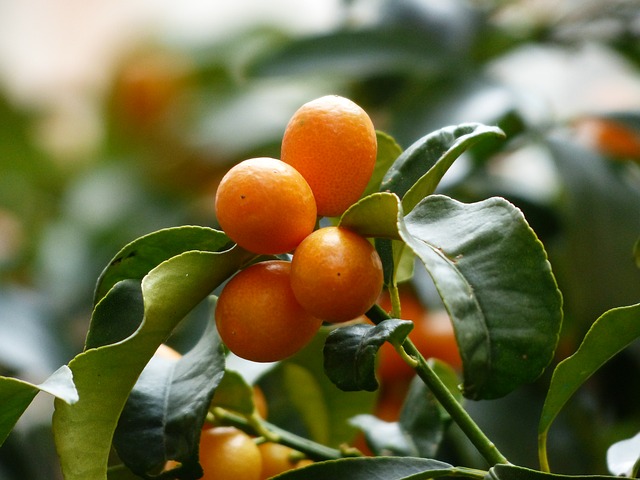Citrus Care

Gardening Question from Joni:
I love your webpage! I could use all the advise you have on caring for my citrus. I planted a navel, valencia, meyers lemon and kumquat 3 years ago. Oranges have some curly leaves and are producing very little. I live in the Shadowridge area of Vista (southwesterly, close to Palomar Airport and Melrose). The trees get primarily morning/early afternoon sun. I had to use a jackhammer to plant them in DG. Drainage is good. Thanks so much for sharing your love and success of gardening!
Answer from Pat:
Thank you for your kind comment. Leaf curl on citrus trees is a worldwide problem. A couple of years ago I spent two weeks on the Amalfi Coast in Italy and noticed with dismay how yellow and curled the lemon leaves were. Those same trees looked pristine and bright green when I had visited Amalfi for two weeks in 1990. Unfortunately, that previously charming and unspoiled area has been named a World Heritage Site so now it’s crowed with people off cruise ships, which means exotic pests are being introduced.
Possible causes of citrus leaf curl are sucking pests, such as aphids, mites and psyllids. In most cases when these are the problem you can see signs of pests feeding under the leaves. In that case wash off the pests often with a soapy spray under leaves using Palmolive dishwash soap or insecticidal soap. Or you can spray under leaves with Neem oil at regular intervals.
Most often, however, leaf curl in Southern California is caused by citrus leaf miners. It’s easy to see the tunnels, like white or yellow winding roads that the larvae make as they tunnel inside the leaves, feeding as they go. No insecticide that can safely be used on a food crop can kill these insects. However, spreading a bag of dry earthworm castings under the drip line of the tree annually and feeding and watering as usual can greatly help the health of the tree since it will increase the chitinase within the tree. Chitin is what the exoskeletons of insects are made of. Chitinase is an enzyme that destroys chitin and thus is a natural defense mechanism contained in plants and also in earthworm castings. (Earthworm castings are not a fertilizer but they can do wonders as a pest control.) Now as the January rains are beginning is an excellent time to spread earthworm castings over the feeder roots of your citrus trees. If you can afford two bags or even three bags of earthworm castings per tree so much the better.
Also be sure you’re watering adequately. Dry soil is another common cause of leaf curl. Decomposed granite has excellent drainage, but little moisture retention so water more often and mulch around and under the trees to increase water retention.
Before mulching be sure to fertilize your trees with one pound actual nitrogen per mature tree in late January. Use proportionately less for young trees. If you are an organic gardener feed with organic citrus food by mid month. When using synthetic fertilizers, feed during the last week of January. Most home gardeners starve their citrus trees.
Finally citrus need full sun. When growing in partial shade pest problems may be greater.



My semi-dwarf, Eureka lemon tree died suddenly in the Spring of 2015. It had fruit albeit they were smaller than last year, very few leaves. One day all of the leaves dropped as if they were blown off the tree by a strong wind. The tree was about 10-12 years old. I faithfully watered the tree and fed it with citrus fertilizer from January through June each year. Up until this point we always had a bumper crop of lemons! I was so proud of them. I put earthworm castings under the tree thinking that I had an infestation of some kind. The LA County Agriculture dept came out to investigate but found nothing. This weekend I bought a replacement tree, an improved Meyer lemon tree, and want to plant it in the same general area because it’s full sun. Can I put it in the same place? If not, what do you recommend?
When citrus trees drop leaves suddenly like that and then die it is usually the result of root damage. This can come from gophers or from sudden dryness or swampy conditions and root rot. We had a very dry year and extreme fluctuations in temperature in 2015. Planting in the same place might be all right if there is nothing wrong with that spot , but it sounds suspiciously as if there is something wrong, like bad drainage. if that is the problem, a raised bed can solve it. It does not need to be very high, even 4 inches would suffice. Gopher damage on citrus usually hits just one side of a tree.
This spring I noticed all my young citrus trees have developed a splotchy yellowish leaf. After an addition of 18-6-8 fertilizer, the Tangelo plants seem to be overcoming the problem, but the sweet lemon is still affected with this condition. Any suggestions as to how handle the problem.
All the plants are grown from seed and are just over a hear old and about two feet tall. They are all potted in a combination of bagged Miracle Grow soil and compost from my nearby pile. The compost consist of horse manure, sawdust and kitchen greens only.
Thanks, I appreciate your suggestions
Blotchy yellow patches on young citrus leaves usually means a mineral deficiency. Also yellow leaves on citrus most likely means a nitrogen deficiency. However, if the veins on the leaves are dark green and the leaf is yellow this means iron deficiency, called chlorosis. In this case apply chelated iron (iron chelates which is iron combined with zinc)— according to package directions. Do not apply iron sulfate since this is not absorbable by plant roots.
It could be that the sawdust or other carbonaceous materials in the soil are not fully decomposed and thus might be subtracting nitrogen from the soil in order to rot. If so, the problem is a lack of nitrogen and can be cured by fertilizing with a balanced organic fertilizer recommended for citrus. Another possibility is that your soil mix is too alkaline or too acid.
Additionally, blotchy yellowing of leaves is often a sign of magnesium deficiency. There is usually plenty of magnesium in our native soils and as long as the pH of the soil is in the right range, this mineral is readily available to plant roots. However, your citrus plants are growing in pots so my guess is that your citrus are most likely suffering from lack of magnesium. To correct this problem, drench the soil with a solution of 2 Tablespoons Epsom salts dissolved in 1 gallon of water. You can also make a solution of 1 teaspoon epsom salts to a pint of water, put it into a spray bottle like the kind used to moisten laundry before ironing and spray the leaves with the solution. Try this anyway and see if it doesn’t green up the leaves.
Citrus trees:
what type of fertilizer should I put for citrus trees?
how to get rid of ants?
one of my orange trees get lots of flowers but not many fruit, all fall off.
Also, my rose tree has some sort of disease like yellowish on leaves and looks like something eating the rose petals, it has hole on it. Can you suggest what I need to do?
If I want to make another tree from what I currently have, how can I cut and get another plant from rose tree?
1. Fertilize citrus under the drip line in January with an organic fertilizer recommended for Citrus trees. Give one pound actual nitrogen per mature tree per year. That means if you use 20-20-20 you need to feed with 5 pounds of fertilizer to get one pound nitrogen. Most home grown citrus are starved for nutrients.
2. Get rid of ants by spreading a thick (2 or 3 inches thick) layer of earthworm castings under the tree beginning two feet from the trunk and covering the roots. This will kill all ants. Cut off any foliage that touches the ground or anything else (tree, wall or building.) This is a pathway for ants. Ants bring aphids which they milk for honeydew. They also bring other pests and diseases.
3. Re: Flowers but no fruit: This means there are no bees. Make sure you or your gardener or next door neighbor are not spraying with pesticides such as Malathion. It kills bees. If your tree has roots in a lawn or flower bed, never use a fertilizer such as Scotts or Bayer Rose and Flower Food containing white grub control. This contains Merit, (imidacloprid). This is the main pesticide that causes Colony Collapse Disorder in bees. Bayer is an evil company as is Monsanto.
4. When there are no bees, you need to hand pollinate the blossoms to get fruit. To do this, use a dry sable watercolor brush and in the early morning after the dew dries, make like a bee by going all over the tree from flower to flower and twirling the brush inside each of them, thus spreading the pollen from blossom to blossom as bees do.
5. When all fruit falls off a fruit tree such as citrus this is due to hoeing, cultivating, digging, or weeding under the tree. Any cultivation of the ground under a citrus tree disturbs the shallow roots of the tree and makes all the the immature fruit fall off. Raking up the leaves under an avocado tree does the same thing to avocados. Mulch the ground under citrus and leave it alone. Water under the drip line and beyond.
6. Many diseases afflict roses. Never purchase a rose simply because you think it’s pretty. Always purchase disease-resistant varieties such as all All-America Rose Winners since 1990 and some prior to that. Look on line for lists of pest-and disease resistant roses. ‘Fourth of July’ climbing rose is a good example.
7. Roses can be grown from cuttings and even from cut flowers, but do not make a cutting of a disease-prone rose.
You asked an awful lot of questions. I suggest you order from Amazon one of the last two editions of my Month-by-Month Book, “Pat Welsh’s Southern California Gardening, Month-by-Month” Completely Revised and Updated 2000. Or “Pat Welsh’s Southern California Organic Gardening, Month by Month.” (2010). Do not purchase the first edition I wrote 30 years ago. It is badly out of date, omits some popular plants and includes many that are no longer grown. All my month-by-month books take the gardener by the hand and tell you what to do and how to do it each month throughout the year.